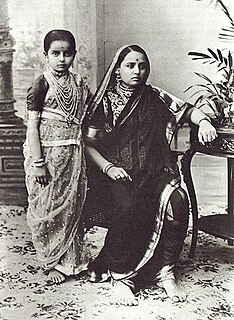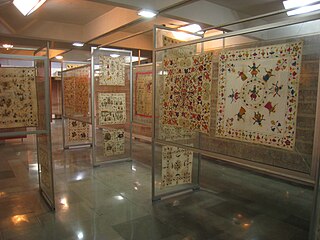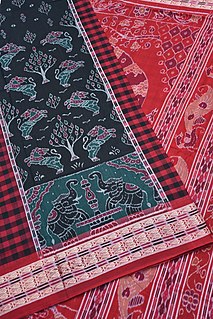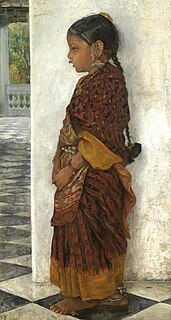
A sari is a women's garment from the Indian subcontinent, that consists of an un-stitched stretch of woven fabric arranged over the body as a robe, with one end tied to the waist, while the other end rests over one shoulder as a stole (shawl), sometimes baring a part of the midriff. It may vary from 4.1 to 8.2 metres in length, and 60 to 120 centimetres in breadth, and is form of ethnic wear in India, Pakistan, Bangladesh, Sri Lanka and Nepal. There are various names and styles of sari manufacture and draping, the most common being the Nivi style. The sari is worn with a fitted bodice commonly called a choli and a petticoat called ghagra, parkar, or ul-pavadai. It remains fashionable in the Indian Subcontinent today.
Ikat is a dyeing technique originating from Indonesia used to pattern textiles that employs resist dyeing on the yarns prior to dyeing and weaving the fabric.
Clothing in India is dependent upon the different ethnicities, geography, climate, and cultural traditions of the people of each region of India. Historically, male and female clothing has evolved from simple garments like kaupina, langota, achkan, lungi, sari, well as rituals and dance performances. In urban areas, western clothing is common and uniformly worn by people of all social levels. India also has a great diversity in terms of weaves, fibers, colours, and material of clothing. Sometimes, color codes are followed in clothing based on the religion and ritual concerned. The clothing in India also encompasses the wide variety of Indian embroidery, prints, handwork, embellishment, styles of wearing clothes. A wide mix of Indian traditional clothing and western styles can be seen in India.

Zari is an even thread traditionally made of fine gold or silver used in traditional Indian, Bangladeshi and Pakistani garments, especially as brocade in saris etc. This thread is woven into fabrics, primarily silk, to make intricate patterns and elaborate designs of embroidery called zardozi. Zari was popularised during the Moghul era; the port of Surat was linked to the Meccan pilgrimage route which served as a major factor for re-introducing this ancient craft in India. During the Vedic ages, the gold embroidery was associated with the grandeur and regal attire of gods, kings, and literary figures (gurus).

Karnataka produces 9,000 metric tons of mulberry silk of a total of 20,000 metric tons of mulberry silk produced in the country, thus contributing to nearly 45% of the country's total mulberry silk. In Karnataka, silk is mainly produced in the Mysore district. It is a patent registered product under KSIC. KSIC is an owner of the Mysore Silk brand.

Paithani is a variety of sari, named after the Paithan town in Aurangabad district from state of Maharashtra in India where the sari was first made by hand. Present day Yeola town in Nashik, Maharashtra is the largest manufacturer of Paithani.

A Banarasi sari is a sari made in Varanasi, an ancient city which is also called Benares (Banaras). The saris are among the finest saris in India and are known for their gold and silver brocade or zari, fine silk and opulent embroidery. The saris are made of finely woven silk and are decorated with intricate design, and, because of these engravings, are relatively heavy.

Embroidery in India includes dozens of embroidery styles that vary by region and clothing styles. Designs in Indian embroidery are formed on the basis of the texture and the design of the fabric and the stitch. The dot and the alternate dot, the circle, the square, the triangle, and permutations and combinations of these constitute the design.
Meera Mehta is a weaver and textile designer, based in Mumbai, India. Textiles she has created have been displayed in museums and galleries around the world. Mehta is best known for her revival of the Paithani sari.

Silk In India, about 97% of the raw mulberry silk is produced in the Indian states of Karnataka, Andhra Pradesh, Tamil Nadu and West Bengal. Mysore and North Bangalore, the upcoming site of a US$20 million "Silk City", contribute to a majority of silk production. Another emerging silk producer is Tamil Nadu where mulberry cultivation is concentrated in Salem, Erode and Dharmapuri districts. Hyderabad, Andhra Pradesh and Gobichettipalayam, Tamil Nadu were the first locations to have automated silk reeling units.

Kota Doria or Kota Doriya is the name of a light woven fabric made of tiny woven squares (khat) which is still handwoven on traditional pit looms in Kaithoon near Kota in Rajasthan and in some of the surrounding villages. Kota Doriya Sarees are made of pure cotton and silk and have square like patterns known as khats on them. The chequered weave of a Kota sari is very popular. They are very fine weaves and weigh very little.

Sabyasachi Mukherjee is an Indian fashion designer, jewelry designer, retailer and couturier from Kolkata, India. Since 1999, he has sold designer merchandise using the label Sabyasachi. Mukherjee is one of the Associate Designer Members of Fashion Design Council of India and the youngest board member of the National Museum of Indian Cinema.He has designed costumes for Bollywood films such as Guzaarish, Baabul, Laaga Chunari Mein Daag, Raavan, and English Vinglish.

A wedding sari is the traditional wedding dress of South Asian women. The sari is traditionally a combination of red and green, with golden brocade.

A Sambalpuri sari is a traditional handwoven bandha (ikat) sari wherein the warp and the weft are tie-dyed before weaving. It is produced in the Sambalpur, Balangir, Bargarh, Boudh and Sonepur districts of Odisha, India. The sari is a traditional female garment in the Indian subcontinent consisting of a strip of unstitched cloth ranging from four to nine metres in length that is draped over the body in various styles.

Silk weaving is a manufacturing industry in Varanasi. Varanasi is known throughout India for its production of very fine silk and Banarasi saris.

Chanderi sari is a traditional sari made in Chanderi, Madhya Pradesh, India.
Uppada Jamdani Sari is a silk sari style woven in Uppada of East Godavari district in the Indian state of Andhra Pradesh. It was registered as one of the geographical indication from Andhra Pradesh by Geographical Indications of Goods Act, 1999. Uppada Jamdani saris are known for their light weight.
Bhagalpur silk is an silk sari made in Bhagalpur, India. More than a century old, Tussar silk weaving industry in Bhagalpur has about 30,000 handloom weavers working on some 25,000 handlooms. The total value of annual trade is around Rs. 100 crores, about half of which comes from exports.

Pochampally sari or Pochampalli ikat is a saree made in Bhoodan Pochampally, Yadadri Bhuvanagiri district, Telangana State, India. They have traditional geometric patterns in "Paagadu Bandhu" (Ikat) style of dyeing. The intricate geometric designs find their way into sarees and dress materials. The Indian government's official airplane company, Air India, has its cabin crew wear specially designed Pochampally silk sarees.

Handloom saris are a traditional textile art of Bangladesh and India. The production of handloom saris are important for economic development in rural India.














